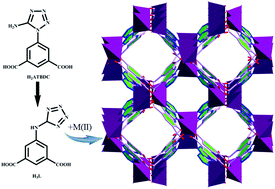Two new metal–organic frameworks based on tetrazole–heterocyclic ligands accompanied by in situ ligand formation†
Abstract
Based on the same in situ formed ligand, two new MOFs, namely {[Zn2(HL)2]·0.5DMF·H2O}n (1) and {[Cd2(HL)2]·1.5H2O}n (2) (H3L = 5-[(2H-tetrazol-5-yl)amino]isophthalic acid), have been solvothermally synthesized and structurally characterized by elemental analysis, IR, PXRD, and single-crystal X-ray diffraction. During the self-assembly process, the original ligand H2ATBDC (5-(5-amino-1H-tetrazol-1-yl)-1,3-benzenedicarboxylic acid) undergoes the Dimroth rearrangement to form a new ligand H3L, consequently contributing to the construction of the two new MOFs. Structural analysis reveals that both 1 and 2 possess a three-directional intersecting channel system and pts topology. The major structural difference between them is the metal coordination, which displays four- and six-coordinated modes in 1 and 2, respectively, and results in diverse channels and different stabilities. Moreover, the adsorption properties of 1a (i.e., the desolvated 1) have been studied, and the results show that 1a possesses moderate capability of gas sorption for N2, CO2, and CH4 gases, along with high selectivity ratios of 102 and 20 for CO2/N2 (15 : 85) and CO2/CH4 (50 : 50) at 273 K, respectively.

- This article is part of the themed collection: Dalton Transactions Inorganic Symposia


 Please wait while we load your content...
Please wait while we load your content...